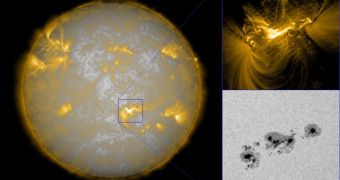Astronomers were recently able to determine what caused the massive solar flare the rippled over the surface of the Sun on February 14. Determining the causes that led to this event is very important, since this was the most powerful flare of its type released over the past five years.
The main conclusion of the investigation is that sunspot interactions are primarily to blame. These are dark regions on the surface of the Sun, which can easily be observed via telescopes, and that are generally considered to be indicators that the star is entering the active phase of its cycle.
The Sun operates in 11-year cycles, in which periods of minimum activity alternate with periods of maximum solar commotion. During the latter, numerous sunspots, solar flare, coronal mass ejections, and other similar phenomena can be observed.
Apparently, sunspots also play an important role in determining the intensity of solar flares. In the new study, it was determined that rotating sunspots were directly responsible for twisting the star's magnetic field. This is what ultimately led to the powerful solar event, experts say.
The new work was conducted by English experts at the University of Central Lancashire, who looked at solar flare data spanning more than 5 days, around the February 14 interval. The readings were collected by the NASA Solar Dynamics Observatory.
SDO is part of the international network of spacecraft that is keeping an eye on the Sun at all times, and in multiple wavelengths. It recorded the solar flare event in exquisite detail, Space reports.
“Sunspots are features where the magnetic field generated in the Sun's interior pushes through the surface and into the atmosphere,” says the lead researcher of the work, expert Daniel Brown.
“Twisting the Sun's magnetic field is like twisting an elastic band. At first you store energy in the elastic, but if you twist too much the elastic band snaps, releasing the stored energy,” he adds.
“Similarly, rotating sunspots store energy in the sun's atmospheric magnetic field. If they twist too much, the magnetic field breaks, releasing energy in a flash of light and heat which makes up the solar flare,” the investigator goes on to say.
Details of the new work were presented in Wales on April 20, at the National Astronomy Meeting of the Royal Astronomical Society. The February solar flare belonged to Class X2.2, and was the most powerful the Sun produced since December 2006.
“Rotating sunspots are an extremely efficient way to inject energy into the magnetic field of the Sun's atmosphere. With five sunspots rotating at the same time enough energy has been injected into the atmospheric magnetic field to produce the largest solar flare seen for almost 5 years,” Brown concludes.

 14 DAY TRIAL //
14 DAY TRIAL //